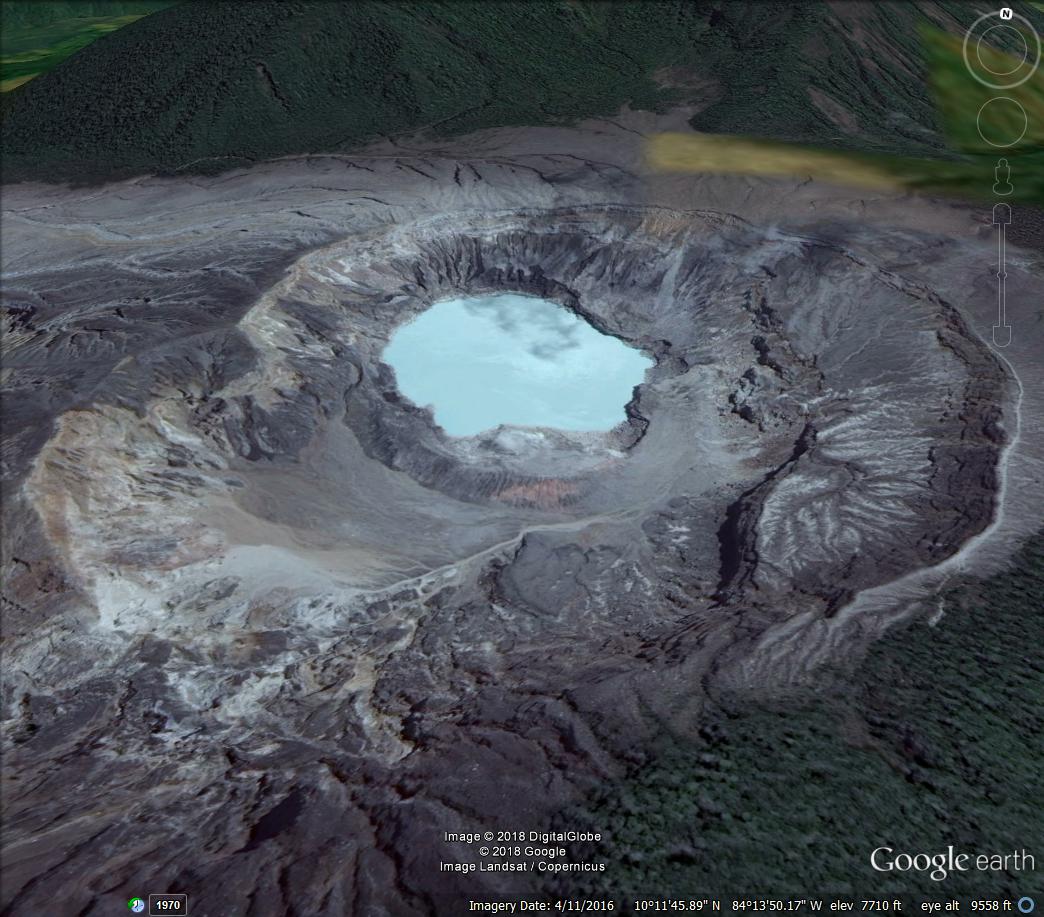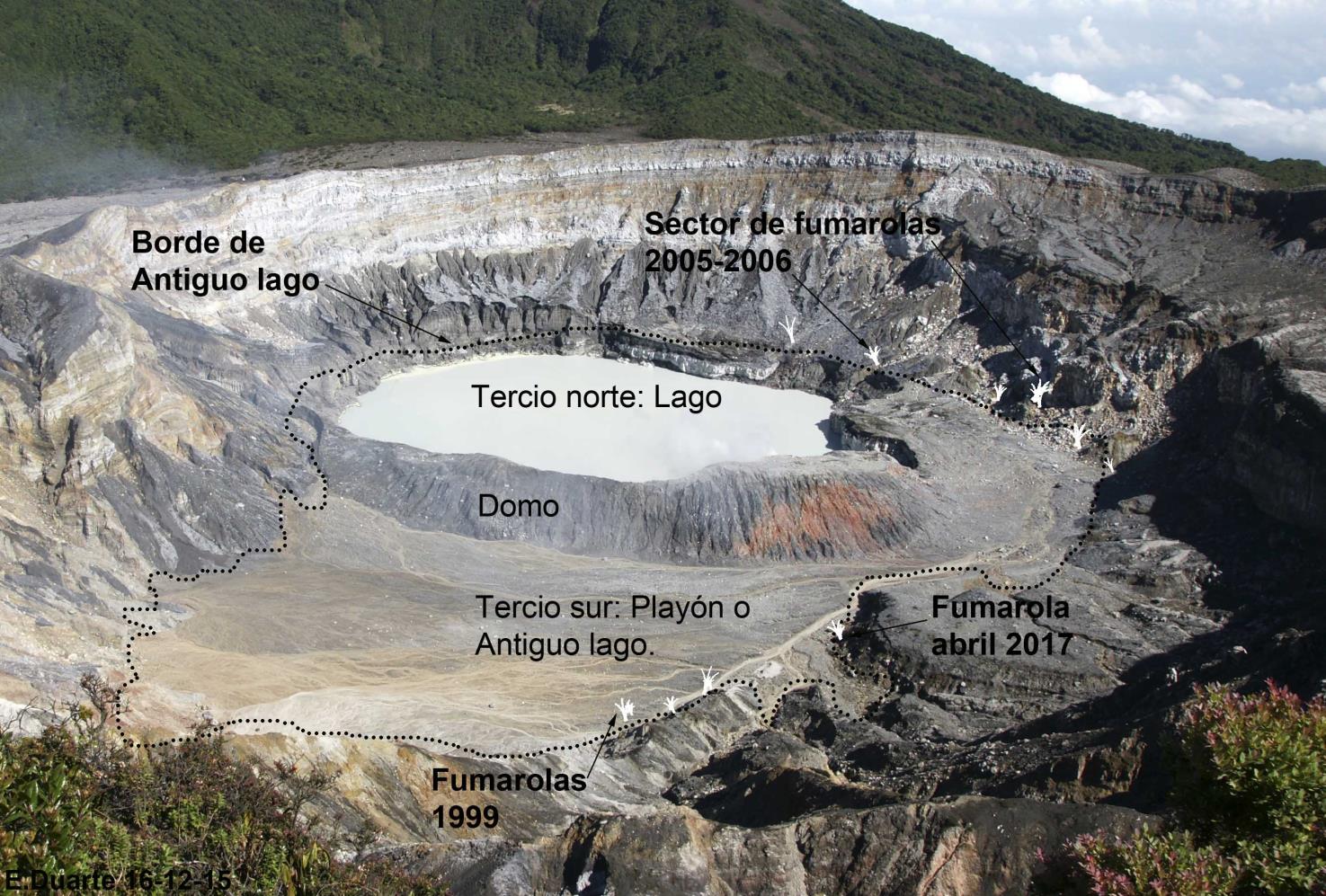Report on Poas (Costa Rica) — March 2018
Bulletin of the Global Volcanism Network, vol. 43, no. 3 (March 2018)
Managing Editor: Edward Venzke.
Research and preparation by Paul Berger.
Poas (Costa Rica) Increase in phreatic and phreato-magmatic explosions during April through August 2017
Please cite this report as:
Global Volcanism Program, 2018. Report on Poas (Costa Rica) (Venzke, E., ed.). Bulletin of the Global Volcanism Network, 43:3. Smithsonian Institution. https://doi.org/10.5479/si.GVP.BGVN201803-345040
Poas
Costa Rica
10.2°N, 84.233°W; summit elev. 2697 m
All times are local (unless otherwise noted)
Recent activity at Poás has been characterized by intermittent phreatic explosions from the hyperacid lake (figure 118). Explosions were noted in June-August 2016 (BGVN 42:03), but there were no reports explosions since then through March 2017. This report summarizes activity from April 2017 through March 2018. During this period, activity increased substantially during April-August 2017 and thereafter waned. No explosions were reported during 7 November 2017-31 March 2018. Information below was primarily drawn from reports issued by the Observatorio Vulcanologico Sismologica de Costa Rica-Universidad Nacional (OVSICORI-UNA).
 |
Figure 118. Landsat imagery of Poás taken 11 April 2016. Courtesy of Digital Globe and Google Earth. |
Activity during April 2017. According to OVSICORI-UNA, activity increased substantially at the beginning of 2017, with significant increases in seismicity, steam-and-gas emissions, and surface deformation. Seismicity included numerous long-period (LP) earthquakes, more than 200 daily events between the end of March and the beginning of April, and weak explosions since 30 March. Deformation was characterized by inflation, with a vertical increase of more than 1 cm in a three-month period and an increase of 3 mm horizontally between two sites S and N of the crater separated by 1,570 m.
Gas emissions dramatically shifted toward a more magmatic composition, particularly after 30 March. Sulfur dioxide measurements on 4 April were about an order of magnitude greater than those on 28 March (~180 ± 65 tonnes/day (t/d) vs. ~19 ± 8 t/d), with the dome contributing 25% and the lake 75% of the flow. The increased flow was accompanied by the emergence of new fumaroles that may have contributed to the warming of the lake (which went from 35 to 40°C in just one week). In April, the lake quickly changed from a milky green color to a milky gray color, which suggested that emissions of magmatic gases from vents beneath the lake may have increased. The dome is on the S side of the crater lake and was formed during phreatomagmatic activity between 1953 and 1955; it has been a site of persistent fumarolic degassing for the last 200 years.
OVSICORI-UNA reported that a strong 40-minute phreatic explosion from an area between the lava dome and the hot lake occurred on 12 April 2017, starting at 1830. A plume of steam, altered rocks, sediments, and gases was produced; the height of the column could not be determined due to poor visibility. Ash fell around the crater and in Bajos del Toro (7 km WNW). The water level in the Desague River, with headwaters at the S part of the crater, increased by 2 m. According to news articles (Tico Times, The Costa Rica Star), the National Emergency Commission evacuated residents living near the river. The Poás Volcano National Park closed the next day and has remained closed through March 2018.
On 13 April, at 1546, an eight-minute-long explosion produced a plume that rose 500 m above the crater rim. The event rendered a webcam on the N rim inoperable. Explosions at 0758 (strong) and 1055 on 14 April generated plumes that rose to an undetermined height.
A 10-minute-long event that began at 0810 on 15 April again produced a plume of unknown height. Frequent (2-3 events per hour) small, short-lived, phreatic explosions were recorded by seismographs during 15-16 April. A plume that rose 500 m followed an explosion at 0946 on 16 April. Later that day, at 1350, an event generated a plume that rose 1 km. A news article (The Costa Rica Star) reported that boulders as large as 2 m in diameter fell in an area 30 m away from a tourist trail, breaking a water pipe. Rocks also damaged fences and concrete floors in viewing areas. Small, frequent, and short-lived phreatic explosions continued to be recorded through 18 April. A video posted by a news outlet (The Costa Rica Star) showed an explosion ejecting incandescent material.
According to OVSICORI-UNA, on 20 April a dense steam plume rose from a vent in the newly-forming pyroclastic cone at the site of the old dome in the hot lake. Sulfur dioxide levels increased from 1,000 t/d on 13 April to 2,500 t/d on 20 April. During 20-22 April Strombolian activity ejected tephra that fell around the vent within a 300-m radius. Gas-and-ash plumes rose 200 m above the vent. The Cruz Roja (Red Cross) in Grecia reported ashfall in Alajuela (20 km S), Fraijanes (8 km SE), San Miguel (40 km SSE), Carbonal (8.5 km SSW), Cajón (11 km SSW), San Francisco, San Roque (23 km SSE), and San Juan Norte de Poás (8.5 km S). Explosions at 1316 and 1603 on 22 April produced plumes of unknown height. Several more explosions were recorded that day; an event at 2212 was very intense, ejecting bombs large distances. An event at 1215 on 23 April generated a plume of unknown height.
Activity during May 2017. OVSICORI-UNA reported that large explosions were seismically recorded at 0621 on 1 May and at 1724 on 6 May, though poor visibility prevented visual confirmation of the events. On 10 May, ash emissions were observed. Gas emissions were measured by an instrument mounted on a drone, revealing a gas plume rich in sulfur dioxide and low in carbon dioxide. Deformation was high, with vertical inflation of 3 cm since February.
During 17-23 May, plumes consisted mainly of gas and steam, sometimes including solid material, that rose no more than 1 km above the vent. During 25-26 May, ashfall was reported in some communities around the volcano. Small phreatic explosions were recorded sporadically during 27-30 May.
Activity during June 2017. An explosion reported by OVSICORI-UNA at 1200 on 2 June generated a plume consisting of steam, gases, and minor amounts of ash that rose 600 m above the crater. Another event recorded at 1353 could not be confirmed visually due to weather conditions. An event at 0858 on 6 June generated a plume that rose 1 km.
During 7-8 June, the webcam recorded strong emissions of steam, magmatic gases, and particulates. A sulfur odor was reported in Alajuela, San Ramon (24 km WSW), and Barva (23 km SSE), and incandescence in the area of the crater was recorded at night. OVSICORI-UNA noted that during 8-9 June, a plume of steam, magmatic gases, and particulates rose from two vents; the lake had evaporated and exposed the vents. A minor sulfur odor was reported on the campus of the Universidad Nacional in Heredia. Explosions at 1610 and 1750 on 11 June generated plumes that rose 300 and 600 m above the crater, respectively. Plumes from the vents rose 1 km during 12-13 June. A sulfur odor was noted in Quesada (26 km ENE), Santa Ana (30 km SSE), San José de Alajuela, and San Juanillo Naranjo.
Gas emissions during 13-15 June rose no higher than 500 m above the crater rim and drifted N. During breaks in weather, observers near the crater on 16 June noted ash emissions rising less than 1 km above the crater rim and drifting N. Ash emissions from events at 1340 on 18 June, and 1100 and 1350 on 20 June, rose less than 1 km.
During 20-25 June, plumes of reddish-colored ash, water vapor, and magmatic gases were recorded rising as high as 500 m above two vents during 20-21 June. Magmatic gases and steam plumes rose as high as 1 km above the vents the rest of the period.
Webcams recorded intense incandescence at night during 28-29 June from the bottom of the crater. A sulfur odor was noted in San Rafael de Poás (12 km SSW) and Vara Blanca (10 km ESE). An event at 1115 on 19 June generated a plume that rose 1 km above the vents. An event at 1450 may have generated a plume, but poor visibility did not allow for confirmation.
Activity during July-December 2017. According to OVSICORI-UNA, frequent, but weak Strombolian activity during 1-4 July ejected incandescent material that fell around vent A (Boca Roja). Plumes of steam, magmatic gases, and particulates rose at most 500 m from the vents.
During 4-9 July, plumes of steam, magmatic gases, and aerosols rose 200-600 m above vents A (Boca Roja) and B (Boca Azufrada). Minor incandescence from the bottom of the crater was observed during 4-5 July, and a strong sulfur odor was reported in some areas of Alajuela and Heredia. During 5-7 July, grayish-red ash emissions rose intermittently from vent A, and on 7 July a loud "jet" sound was noted in Mirador. A strong sulfur odor and minor ashfall was reported in some areas of Alajuela. An event at 1450 on 10 July generated a plume that rose 300 m.
OVSICORI-UNA reported that during 12-17 July, gas plumes rose as high as 1 km above vents A and B and drifted SW and NW. From 19 through 24 July plumes of steam, magmatic gases, and aerosols were emitted from vent A, and plumes of steam, gases, and abundant yellow particles of native sulfur rose from vent B. Plumes rose 300-500 m above the vents and drifted W and SW.
On 1 August an event passively produced a plume that rose 500 m above the crater. Incandescence from the bottom of the crater was recorded at night by the webcams. Sulfur dioxide was emitted at a rate of 1,000-1,500 t/d. Activity on 3 August was similar to that in July, except that plumes rose as high as 1 km above the vents. Gas plumes continued to rise from the vents and drift SW and NW at least through 8 August. OVSICORI-UNA reported additional explosions on 22 August (1517 local), 24 August (0920 and 0930), 29 August (0945), 13 September (0820), and 6 November (0915) that rose 300-600 m above the crater rim.
Seismicity. During May and June, some volcano-tectonic (VT) and LP earthquakes were recorded, and tremor levels generally ranged from low-to-moderate amplitude, although higher tremor levels were sometimes detected during 22-30 May. The tremor amplitude often corresponded to the vigor of emissions of steam, magmatic gases, and material from fumarolic vents. Seismic activity was not identified after 30 June, except for a single report that indicated that during 11-14 August seismographs detected low-amplitude tremor, some VT earthquakes, and high-frequency signals indicating gas emissions.
Geological Summary. The broad vegetated edifice of Poás, one of the most active volcanoes of Costa Rica, contains three craters along a N-S line. The frequently visited multi-hued summit crater lakes of the basaltic-to-dacitic volcano are easily accessible by vehicle from the nearby capital city of San José. A N-S-trending fissure cutting the complex stratovolcano extends to the lower N flank, where it has produced the Congo stratovolcano and several lake-filled maars. The southernmost of the two summit crater lakes, Botos, last erupted about 7,500 years ago. The more prominent geothermally heated northern lake, Laguna Caliente, is one of the world's most acidic natural lakes, with a pH of near zero. It has been the site of frequent phreatic and phreatomagmatic eruptions since an eruption was reported in 1828. Eruptions often include geyser-like ejections of crater-lake water.
Information Contacts: Observatorio Vulcanologico Sismologica de Costa Rica-Universidad Nacional (OVSICORI-UNA), Apartado 86-3000, Heredia, Costa Rica (URL: http://www.ovsicori.una.ac.cr/); National Emergency Commission (CNE) (Comisión Nacional de Prevención de Riesgos y Atención de Emergencias (CNE) (URL: http://www.cne.go.cr); Tico Times (URL: http://www.ticotimes.net/); The Costa Rica Star (URL: https://news.co.cr/).


